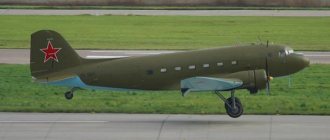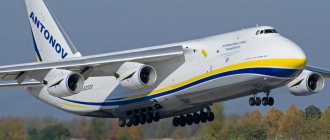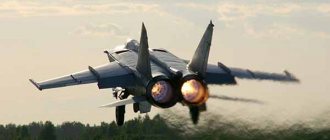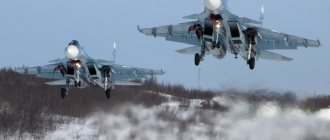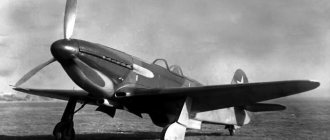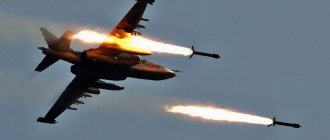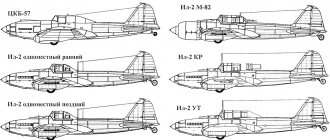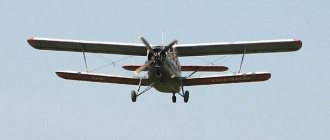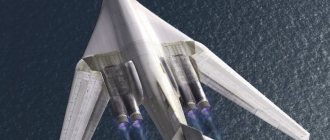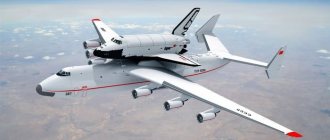Tu-126, which according to NATO codification was called “Moss”, is an aircraft that was intended for radar patrol and identification of sea and air targets. It was equipped with the Liana radar system.
History of Tu-126
The most dangerous for the Soviet Union in 1950 were American strategic bombers carrying nuclear weapons. Since the most likely area for a breakthrough was the northern direction and the construction of ground-based radars required large investments, at one of the government meetings it was decided to construct an airborne early warning radar complex. On July 4, 1957, Resolution No. 608-293 of the Council of Ministers of the USSR was issued, in which the task of constructing such a complex was entrusted to A. Tupolev Design Bureau.
Initially, it was planned to build the complex on the basis of the Tu-95 aircraft. 2 years after the start of research work, the idea of a strategic bomber had to be abandoned. They found a better replacement for him. The most suitable for accommodating a huge amount of radio equipment was the Tu-114 passenger aircraft. It was his design that was taken as the basis for the design of the Tu-126. According to the resolution of the Council of Ministers of the USSR No. 567-230 dated May 30, 1960, the design bureau named after was appointed as the developer of the aircraft. Tupolev, the developer of the Liana radio complex was NII-17, and the manufacturer was Kuibyshev Aircraft Plant No. 18. Designer A.I. had the opportunity to manage the design work directly at the manufacturing plant. Putilov, who headed the branch of the Design Bureau named after. Tupolev in Kuibyshev.
Tu-126 Engine. Weight. Story. Range of flight. Service ceiling
Aircraft armed with a powerful surveillance radar can best detect air targets at distant approaches. An aircraft for these purposes must have a long flight duration - 10-12 hours, a service ceiling of 8000-12,000 m and a considerable flight range. By the end of the 1950s. the most suitable were the aircraft of the A.N. design bureau. Tupolev. According to government decree No. 608-293 of July 4, 1958, this design bureau was tasked with designing and building an AWACS complex for detecting air and sea targets based on the serial Tu-95 bomber. The topic in the design bureau was designated aircraft “126”, the official name was Tu-126 (aircraft “L”).
The analysis and the first evaluation projects of the design bureau showed that creating a complex based on the Tu-95 is inappropriate; it would be more rational to use the Tu-114 passenger aircraft. The fuselage of the Tu-114 made it possible to place a large amount of electronic equipment, provide it with normal temperature conditions on board and create acceptable conditions for long-term work of the crew, which was supposed to consist of two shifts of 12 people. At the beginning of 1960, the Air Force determined the base aircraft on which AWACS equipment should be installed - based on the production Tu-114. On May 30, 1960, a new USSR government decree No. 567-230 was issued, in which plant No. 18 was instructed to build the Tu-126 aircraft with the Liana on-board equipment complex. The Liana radar was created at the Moscow Research Institute of Instrument Engineering under the leadership of A.T. Metelsky. The station's antenna was located in a rotating dorsal fairing; the radar was capable of detecting air targets at a range of up to 350 km, and large sea targets at a distance of up to 400 km. The aircraft was supposed to be used in the Arctic theater of operations, where there was no continuous radar field.
Work on the Tu-126 aircraft proceeded quite quickly, the preliminary design was approved in August 1960, and in December the aircraft mock-up was accepted. The fuselage underwent the most significant changes in the Tu-114 airframe. A fairing of the astrosextant heads was installed in the bow, and under the fuselage there was an air intake for the cooling system of the Liana radar, the antenna of which was placed in a rotating fairing with a diameter of 11 m on a pylon in front of the keel. The antenna rotated in flight at a speed of 10 revolutions per minute. A problem arose with ordering a large bearing for a rotating unit; these simply did not exist in the country. Thanks to the energy of A.N. Tupolev, the production of such bearings was mastered in Moscow. There was a hatch inside the pylon for maintenance, and the height of the fairing allowed a person to move freely in it. The passenger cabin of the base aircraft underwent a significant change; the front and middle parts of the fuselage were occupied by consoles with operator workstations, and radar and communications units were located in the rear part. In the aft part of the fuselage, to improve directional stability, an additional keel was installed below, and the antennas of the “Harp” matching device were attached to the ends of the stabilizer.
The first prototype Tu-126 aircraft was built in the fall of 1961. The first flight took place on January 23, 1962 with a crew led by test pilot I.M. Sukhomlin. The first seven test flights were carried out with a mock-up of the Liana station. Flight tests continued until April 1965, although already in November 1963 the aircraft was put into mass production. The stability and controllability characteristics of the Tu-126 aircraft with a radar on top were practically no different from the characteristics of the Tu-114. A total of nine vehicles were built; on production vehicles, a container with electronic control equipment was installed in the rear, and an in-flight refueling system, similar to that used on the Tu-95, was installed in the bow. The disadvantage of the Liana radar was the inability to determine targets against the background of the ground, and the appearance in the 1960s. aircraft capable of penetrating targets at low altitude made the Tu-126 complex practically helpless. In 1984, Tu-126 aircraft were removed from service, replaced by new A-50s with the Shmel radar.
Design and development [edit]
In 1958, growing concern about the threat of an American nuclear attack on the USSR from the north led to a new requirement for an airborne radar system that would avoid the problems and costs associated with attempting to create a ground-based radar system that would cover the entire vast Soviet northern coast. The Tupolev Design Bureau was tasked with designing the AEW&C aircraft. After an attempt to install the designed radar equipment on the Tu-95 and Tu-116, it was decided to use the Tu-114 instead. The Tu-114 with a wider fuselage. This solved the cooling and operator space problems that existed with the narrower Tu-95 and Tu-116 designs. To comply with flight range requirements, an air-to-air refueling probe was installed on the aircraft. The Tu-126 had a crew of 12 people and carried a Liana
(NATO classification
Flat Jack
) in a dome mounted above the fuselage. It did not have the ability to look down, so NATO's move to low penetration rendered it irrelevant. [1]
The first prototype of the Tu-126 took off on January 23, 1962. [2] Testing, which continued into the fall of 1964, showed that although the radar was effective over water, its performance was poorer on land. [2] It was also discovered that the large counter-rotating propellers of the four engines seriously degraded radar performance. This problem was only helped to a small extent by the installation of a new radar called Bumblebee.
. [3]
Performance characteristics of the Tu-126
— Chief designer: A.I. Putilov - First flight: 1962 - Start of operation: 1965 - End of operation: in 1980 - Units produced: 9
Tu-126 crew
— 4-5 (plus 7-8 AWACS operators)
Tu-126 engine
— TVDx4, NK-12MV — Power, kW: 4 x 11035
Dimensions of Tu-126
— aircraft length: 54.1 m — wingspan: 51.1 m — height: 15.5 m
Weight of Tu-126
— Empty weight: 105,000 kg — Normal take-off weight: 170,000 kg — Maximum take-off weight: 175,000 kg — Internal fuel: 72,980
Speed of Tu-126
— maximum speed at an altitude of 9,000 m: 790 km/h — cruising speed: 650–700 km/h
Service ceiling of Tu-126
— 10,700 m
Flight range of Tu-126
— Practical range, km: 12550 — Flight duration, h.min: 25.0
History of operations[edit]
A-4Es from USS Intrepid
intercept a Tu-126 over the Mediterranean in 1973
The Tu-126 entered service in 1965, although Western intelligence only identified it in 1968 after appearing in a Soviet documentary. [2] Eight production aircraft were built in addition to the prototype from 1965 to 1968, [2] [4] all nominally based at Siauliai Air Base. According to Western intelligence estimates, its radar was inferior in performance to its Western counterparts and could not detect cruise missiles or small aircraft at low altitude. However, it was found that the Tu-126 had powerful jamming equipment. The Tu-126 was used by the Soviet Air Force until it was replaced by the Teriev A-50. The last Tu-126 was written off in 1984. [5]
Alternative AWACS aircraft Tu-129. USSR
Home » Alternative aviation » Alternative Tu-129 AWACS aircraft. USSR
Alternative aviationAlternative aviation
Serg 11/25/2013 641
1
in Favoritesin Favoritesfrom Favorites 0
In the 50s, the problem arose of ensuring the protection of the northern borders of the USSR (the northern direction was the most likely for the appearance of American strategic bombers). The construction of a network of ground-based radars beyond the Arctic Circle required time and enormous costs. The solution to this problem could be provided by long-range radar detection aircraft (AWACS).
Development of the AWACS aircraft according to Resolution of the USSR Council of Ministers No. 608-293 dated July 4, 1958 and GKAT Order No. 211 dated July 17, 1958. The head design bureau for the complex as a whole was appointed OKB-156 by A.N. Tupolev, the development of radar and equipment was carried out by the Research Institute -17, OKB-373, NII-25 and NII-101. By the end of 1958, the Customer issued detailed tactical and technical requirements for the creation of the aircraft - the requirements were approved by the Air Force command on April 9, 1959, and by the Air Defense Command on September 2, 1959.
The AWACS aircraft was originally designed on the basis of the Tu-95 heavy bomber using the promising Ozero radar.
But the Tu-95 was not allowed to accommodate the radar complex equipment due to the small volume of the fuselage. The OKB offered the customer a version of the AWACS aircraft based on the passenger Tu-109*, which in turn was created on the basis of the Tu-19* bomber, “90” ( ), which in turn was a modification of the Tu-16 with the NK-12 theater of operations.
The main problem turned out to be ensuring that the antennas were of sufficient size, on which the signal power and sensitivity of the receiver depended. This problem was solved by placing a long antenna plate in a disc-shaped streamlined body (the Americans used a similar solution much later).
By 1960, after research work carried out by S.M. Yeger, it was decided to choose the Tu-109 passenger aircraft as the base one because it was better suited for housing equipment and personnel than the Tu-95. The advantages also included a sealed interior, the fact that the car was already mass-produced at KhAZ and its relative cheapness compared to the Tu-95. It was also not unimportant that the Tu-109 could be operated from medium-sized airfields with a runway length of up to 2800 m, which significantly expanded the geography of its use.
The general view of the Tu-129 based on the Tu-109 was approved on January 30, 1960, and the Resolution of the USSR Council of Ministers No. 567-230 of May 30, 1960 set the creation of an aircraft with the Liana radar. Development of the aviation complex Liana radar - a variant of the well-known ground-based station P-30, was carried out by Research Institute-17 of the USSR Ministry of Radio Industry. The production of the aircraft was planned at the KhAZ aircraft plant in Kharkov.
According to the project, the most significant changes concerned the design of the fuselage and the composition of the equipment, as well as a number of aircraft systems. The flight crew cabin remained virtually unchanged, only the navigator's workplace became a little cramped due to additional equipment. The fuselage was divided into compartments. The first housed the on-board computer, operator seats and part of the Liana blocks. Behind it there was a wardrobe, in the second compartment there was a workplace for the gunner of a remote aft cannon installation, which consisted of two AM-23 cannons, a Krypton sighting radar and a television sight. In the next, fourth compartment there were resting areas. In the fifth, blocks of the Liana station were installed. The sixth compartment housed the units of the Crystal radio system. In the area of the fifth compartment, a powerful pylon was installed on the fuselage, on the top of which a rotating fairing with a radar antenna unit was attached.
Some of the aircraft systems units and electronic countermeasures equipment were also located there. A fairing of liquid and air radiators was mounted under the fuselage in the area of the fifth compartment, with the help of which the normal temperature conditions of the Liana station blocks were maintained. To ensure acceptable characteristics of directional stability and controllability of the aircraft, an additional large-area fin-ridge was attached under the rear fuselage. The number of portholes has been significantly reduced.
The prototype was ready in mid-1960. On January 23, 1961, the crew of test pilot I.M. Sukhomlin took it into the sky for the first time. Tests continued until November 1961 (mainly the Liana complex was being finalized). In April 1962, the Tu-129 was put into service.
The Liana complex could reliably detect air targets flying at high and medium altitudes. Detection range of air targets in the upper hemisphere for targets like MiG-17 - 100 km, Il-28 - 200 km, ZM -300 km, sea targets up to 400 km, Radar radiation detection range - 500-600 km, data transmission range to air defense and naval command posts - 2000 km.
The aircraft's equipment included an expanded on-board communications and navigation system, which made it possible to exchange data with ground, ship and air command posts. From the Tu-129 it was possible to target fighters and anti-aircraft missile systems, warships and coastal batteries (at sea targets). Production aircraft differed from the prototype in the presence of a “Rhomb” radio reconnaissance station and an in-flight refueling boom of the “hose-cone” type.
The Tu-129 was armed with a rear defensive installation with two AM-23 cannons with a Krypton targeting radar and a television sight.
During operation, the aircraft were retrofitted with additional radio and electronic reconnaissance equipment. Some of the aircraft were equipped with electronic warfare equipment (installed in the tail section).
| LTH: |
| Modification | Tu-129 |
| Wingspan, m | 34.54 |
| Aircraft length, m | 38.85 |
| Aircraft height, m | 11,90 |
| Wing area, m2 | 174,40 |
| Weight, kg | |
| empty plane | 53000 |
| maximum takeoff | 78000 |
| engine's type | TVD NK-12VM |
| Power, hp | 2 x 15,000 |
| Maximum speed, km/h | 820 |
| Cruising speed, km/h | 620 |
| Practical range, km | 10 550 |
| Flight duration, h.min | 25.0 |
| Practical ceiling, m | 11000-12000 |
| Crew, people | 4-5 (plus 6-12 AWACS operators) |
The flight crew is two pilots, a navigator, a flight engineer and a radio operator.
The radar personnel are the commander (guidance officer), four operators and an engineer - one shift of personnel. Due to the long flight duration, there were two shifts of radio technical personnel on board.
Patrol time is 15 hours with one refill.
From 1961 to 1968, 49 production Tu-129 aircraft were manufactured at the Kharkov Aviation Plant.
The vehicles entered service with AWACS squadrons of the air defense armies and navies of the USSR.
The aircraft conducted radar patrols and electronic reconnaissance in Eastern Europe, in the south of the USSR, in the waters of the Barents, Kara, Baltic, Black and Mediterranean seas, guided interceptors to targets northwest of Novaya Zemlya, and monitored sea and air targets in the Pacific, Atlantic and Arctic Ocean.
After the start of their operation, the target detection line was extended to more than 2000 km, and, given the speed of the aircraft, this line could be created in any direction in no more than three hours. The mobility of the Tu-129 made it possible to maneuver in depth and direction, ensuring the build-up of air defense systems at any point in any theater of military operations, which was extremely important given the gigantic size of the USSR. For example, it took only 10 hours to transfer aircraft from the Kola Peninsula to the Vladivostok area. The actions of the Tu-129, patrolling at high altitude, depended little on the weather, while the actions of radar patrol ships could be greatly hampered by storms, rain or snow. They could perform their functions over the Arctic Ocean, where solving radar patrol tasks by ground and shipborne means was practically impossible at that time.
A special feature of the Tu-129 was its low vulnerability when performing a combat mission. It was ensured by the fact that this aircraft could not be destroyed by missiles with passive radar guidance systems. The air-to-air or surface-to-air missiles that existed at that time were ineffective in combating him, since he himself detected them long before approach using on-board radar and electronic reconnaissance equipment. This made it possible to perform a maneuver and disrupt the capture of a target by special equipment. The Tu-129 could perform the functions of a reconnaissance officer for naval formations that included aircraft carriers. A sufficiently high flight speed gave him the opportunity to avoid interception by carrier-based fighters.
During operation, the Tu-129 was retrofitted with additional electronic reconnaissance equipment, the communication system with ground command posts was improved, and unified tail compartments (CWD) with electronic electronic equipment were installed on some aircraft.
Tu-129s were used in the air defense system in the northern and eastern regions, over sea and ocean spaces, working against air targets. At the same time, they interacted with long-range fighter-interceptors, including the Tupolev Tu-128 and Tu-128M. It turned out that joint actions could ensure that the interception lines for air targets flying at speeds of up to 900 km/h (for example, American B-52 and B-47 bombers, as well as the British “V” family) were placed 1000 km from the coastline. In this regard, a guidance officer was added to the Tu-129 crew. Thus, guidance of air defense fighters was added to the long-range detection functions, although initially the tactical and technical requirements for such use of the complex were not provided for.
Tu-129 served in Cuba, patrolling the Caribbean Sea and the Atlantic. During the Vietnam War, Tu-129s strengthened the air defense of North Vietnam. They made a certain contribution to the result of the Arab-Israeli War of 197X.
In 1971, during the Indo-Pakistan incident, 1 aircraft took part in guiding Indian Su-7BKL fighter-bombers to targets in Pakistan. With the beginning of the Iran-Iraq War, Tu-129 aircraft began to be constantly on duty at the southern borders of the USSR, monitoring both warring sides.
The vehicles were based in Cuba, Nicaragua, Egypt, Angola, Ethiopia and Indonesia.
They were often involved in various large-scale Navy exercises (“Ocean”, etc.).
The planes were in service until 1979, when they were replaced by new aircraft. One Tu-129 was converted in the 70s to test the Shmel complex (installed on the A-50).
Some of the vehicles were subsequently sold to the allies of the USSR.
This could have been the first production AWACS aircraft of the USSR, before the Tu-12.6, if the “90” aircraft had gone into production.
*- Tu-109 and 129 are fictitious names. Tu-109 - Tu-104 with theater.
Drawings: Sergey Sych
Best regards, Sergey Sych
Sources: Vladimir Rigmant. Under the signs "ANT" and "TU"
Roman Astakhov. Russian Power. Aircraft AWACS Tu-126 Aviation and Cosmonautics. Evgeny Klimovich. Mikhail Nikolsky. Development and use of airborne early warning and control aircraft
Links[edit]
Notes[edit]
- https://aerospace.boopidoo.com/philez/Su-15TM%20PICTURES%20&%20DOCS/Overscan%27s%20guide%20to%20Russian%20M military% 20Avionics.htm Archived 07/07/2012 in archive.today
- ^ abcd Duffy and Kandalov 1996, p. 136.
- "Beriev A-50 Oplot." spyflight.co.uk.
Access date: October 27, 2011. - ^ a b Gunston 1995, p. 434.
- Pike, John, ed. "Tupolev Tu-126 Mokh". Globalsecurity.org.
Access date: October 27, 2011. - Jump up
↑ Taylor 1988, p. 267.
Bibliography[edit]
- Duffy, Paul and Kandalov, Andrey. Tupolev: Man and his plane
. Shrewsbury, UK: Airlife, 1996. ISBN 1-85310-728-X. - Gunston, Bill. Encyclopedia of Russian Aviation Osprey 1875–1995.
London: Osprey, 1995. ISBN 1-85532-405-9. - Taylor, John W.R., ed. Airplanes of the World Jane 1988–89
. Coulsden, Surrey, UK: Jane's Information Group, 1988. ISBN 0-7106-0867-5.
- Efim Gordon, Dmitry Kommisarov: Flight Craft 6: Ilyushin / Beriev A-50. Pen & Sword Books Ltd, 2015, ISBN 978-1-4738-2391-4
